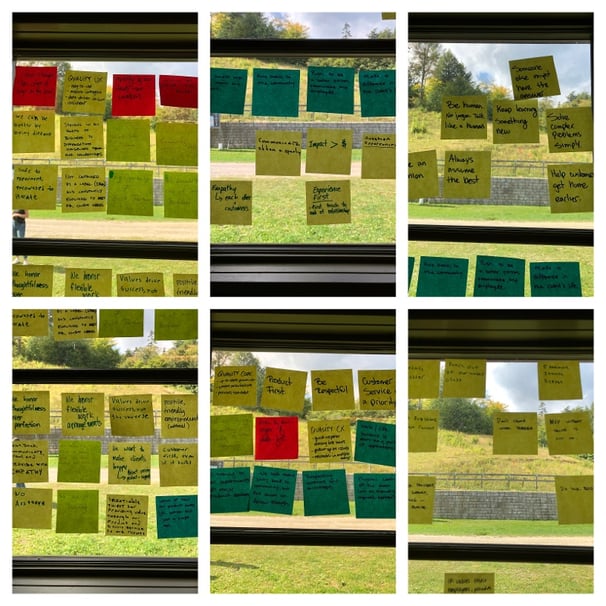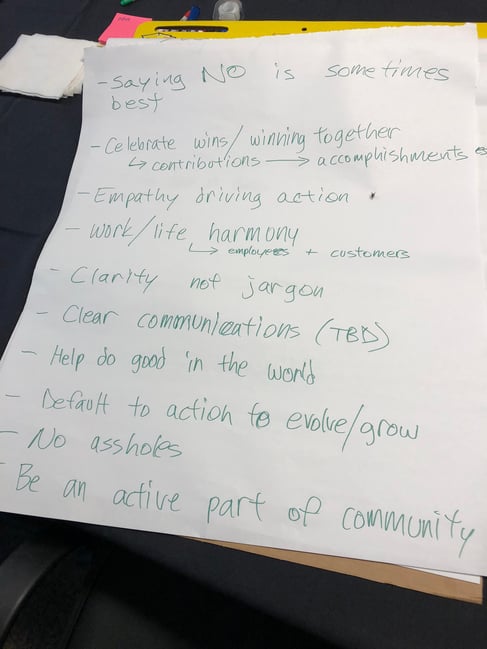Recommitting to Values - Image Relay’s Core Values Workshop


I joined Image Relay a couple of years ago. What attracted me most was meeting the team and the opportunity to work with a group that was creative and open, and hard-working but not emotionless. Another driving factor was Image Relay’s B Corp status.
I’m a fan of B Corps and always seek out companies that do good when I’m shopping. I look for those words that might mean something - like local, minority-owned, organic, employee-owned, sustainable, women-owned, etc. As a marketer, I know how these terms get used and abused, so I like to dig a bit deeper and see if a company’s commitment is legit. Are they really doing something good or is it just a way to sell more stuff? It was the same for Image Relay, I wanted to find out what the B Corp status meant for them.
Skye Chalmers, Image Relay’s founder and CEO, talked about a commitment to the team and being a different kind of company. Flexible work schedules and arrangements. Time off for volunteer work. Good benefits. The rest of the team said something similar. They also talked about other differences at Image Relay. Things like lots of responsibility and self-direction, and no jerks.
It sounded great. And it’s all true.
Over the past two years I have experienced all of the things the team talked about during the interview, and felt how Image Relay is different.
As we’ve grown, doubling the size of the team in less than two years, holding onto that difference was important and becoming more challenging. How could we keep what we had as a small group mostly in Vermont as a larger group throughout the US. We knew the answer was in our core values, but there was a problem . . . we couldn’t state our values.
We could talk about how we were different but could not give a clear story about why.
Last year, we decided to get serious. We had ambitious goals, were adding team members quickly, and we needed our team engaged and aligned.
We committed to documenting our core values. And I was going to lead the process.
Ok, now what?
No one on the team had done this before. Google, as you could have guessed, is very helpful for these kinds of things, though. There are all sorts of guides and recommendations out there for developing your core values. Two that stood out were from Recruiting Social and Scott Jeffrey.
Recruiting Social provided a thorough guide for an in-depth, thoughtful process. It was a great place to start.
Scott Jeffrey’s post immediately struck a chord with the title. He used the word “discover.” This process is not about creating values from scratch, it is about discovering what is already there and where an organization hopes to go. We weren’t building these things, we were putting words and intention to the things that we already felt.
Taking the guidance from Scott Jeffrey and Recruiting Social we developed a process to fit into a two-day offsite when our entire remote team was in one place.
Step 1: Lay the ground rules
Step 2: Survey the team
Step 3: Review other examples
Step 4: Get it all out
Step 5: Organize into themes
Step 6: Discuss and vote on themes
Step 7: Challenge and refine the list
Step 1: Lay the ground rules
Ground Rule #1: Everyone contributes.
We didn’t want this process to be a lame corporate training exercise. We wanted it to mean something to our team. Our values aren’t something to just post on our website, they are meant to serve as guides for our team. When we’re faced with tough decisions like who to hire, who to partner with, or what product direction to go in, will the values we’ve developed guide us? We needed the answer to be yes and that required input from everyone on the team.
Ground Rule #2: Specific ideas only.
We would not accept ideas like “transparency” as a value. Generic words lead to meaningless values that don’t serve any purpose. The values need to be actionable. Being specific and clear is critical.
Ground Rule #3: All ideas get respect.
This was non-negotiable. Even if a team member didn’t like an idea from someone else, that idea still received respect. It’s no surprise that this idea ultimately ended up in our final list of values.
Step 2: Survey the team
A few days before meeting as a team, we asked everyone to come up with an individual list of what values they think Image Relay currently stands for and what they would like to see Image Relay stand on. This provided a good starting point and helped get everyone’s head into the exercise. Nothing is worse than starting a workshop without a warmup and everyone just sits there looking at each other. We had the time to reflect in advance and could all bring fleshed out ideas to the table.
What do you think Image Relay stands for?
What do you want Image Relay to stand for?
Step 3: Review other examples
We looked at examples of company values from about twenty companies. We wanted everyone to see examples from other companies to see if it might spark other, new ideas. Doing this after everyone had thought of their own values allowed us to spark new ideas without coloring all our thoughts.
Below are some of the examples we reviewed. Some we liked. Some we didn’t.
Zappos
1. Deliver WOW Through Service
2. Embrace and Drive Change
3. Create Fun and A Little Weirdness
4. Be Adventurous, Creative, and Open-Minded
5. Pursue Growth and Learning
6. Build Open and Honest Relationships With Communication
7. Build a Positive Team and Family Spirit
8. Do More With Less
9. Be Passionate and Determined
10. Be Humble
Adidas
• We are committed to continuously strengthening our brands and products to improve our competitive position.
• We are consumer-focused and therefore we continuously improve the quality, look, feel and image of our products and our organisational structures to match and exceed consumer expectations and to provide them with the highest value.
• We are innovation and design leaders who seek to help athletes of all skill levels achieve peak performance with every product we bring to market.
• We are dedicated to consistently delivering outstanding financial results.
• We are a global organisation that is socially and environmentally responsible, that embraces creativity and diversity and is financially rewarding for our employees and shareholders.
Nature’s Path
1. Performance Driven: Demonstrating initiative in supporting the goals and overall strategy of the company.
2. Always Improving: Commitment to LEAN, creative problem solving and continual improvement.
3. Team Focused: Developing a culture of high-functioning and supportive teams.
4. Honorable and Respectful: Contributing to a work environment that honors and respects the needs of each stakeholder.
5. Sustainably and Socially Conscious: Involvement in practices that decrease our negative environmental impact and increase our positive community impact.
Bain & Company
1. Passion
2. Commitment
3. Honesty
4. Openness
5. Practical
6. “One-team” Attitude
7. Not Taking Ourselves Too Seriously
Darn Tough
• We are direct, straightforward and truthful.
• We value honesty and a hard day’s work.
• We are penny foolish and pound wise.
• We are tough, independent and respectful.
• We value families.
• We value differences.
• We wear it on our sleeves.
• We are authentic.
• We have yet to produce our best sock.
Step 4: Get It All Out
After thinking about Image Relay individually and engaging as a team with real world examples, we put all the ideas out there. Each team member posted a value on a post-it note and put it on the wall. Our team of 10 added nearly 100 values to the wall. The ideas covered everything from how we engaged with each other at work to how we build our product. This giant list served as a master list. All of our core values, or at least the underlying ideas for the values, were now on the wall.

Step 5: Organize into Themes
With the master list now on the wall, we grouped values on post-its into related themes. Some were nearly word for word and others had a close relationship to another value on the wall. In the end we had about 20 smaller groups of values. Some groups had more than a dozen overlapping ideas and other groups had a single solitary post-it note hanging onto the wall.
We reviewed the themes as a group and made sure that the team member who posted a value that wasn’t immediately clear could explain what they meant with their post-it.
Step 6: Discuss and Vote on Themes
With the themes properly grouped, each team member received eight small round stickers to use as a vote on a group of values. We all went up and popped a sticker on the group of values we would like to see on the final list.
-1.jpg?width=291&height=873&name=BeFunky-collage%20(1)-1.jpg)
Some were overwhelming favorites with nearly every team member adding their voting sticker to group, and others had only one sticker. Some groups didn’t get any votes. With the votes tallied, it was time to discuss.
We had an open dialogue about why we chose the themes we did. Again, everyone had to contribute. We also questioned why some groups were left behind.
With everyone feeling aligned and no one needing to argue for something we overlooked, we ended with the following short list:
1. Saying NO is sometimes best.
2. Winning together.
3. Empathy driving action.
4. Work/life harmony.
5. Clarity not jargon.
6. Clear communications.
7. Help do good in the world.
8. Default to action to evolve/grow.
9. No assholes.
10. Be an active part of community.

Step 7: Challenge and Refine the List
With the list in hand, it was time to test our values and make the final list. Testing the values is important. We have to be sure these values serve their purpose of being actionable and providing a guide for our team.
Scott Jeffrey provides a number of great questions to ask when challenging the values. These are a few of our favorites:
Will each value help you make decisions (especially the difficult ones)?
Are your values congruent with your behavior (when you’re at your best)? Are these values BS-tested? Will an employee be able to observe hypocrisy?
Can your organization uphold these values in stressful and difficult situations (like increased competition, product recalls, market turbulence, or downsizing)?
The challenge questions led to further discussion and new ideas, and some more challenging. This debate gave us the opportunity to adjust language and in the end we had a list of nice core values. They range from how we interact with each other to how we talk to customers, from what we hope to provide as a company to our expectations for professional growth.
Here is the current iteration of Image Relay’s core values. We’re still working through these and wanted to provide the appropriate context for each one.
1. Empathy drives our actions.
We honor different perspectives and experiences. We seek to understand these differences and engage appropriately. This empathy is what shapes our interactions and controls how we build our product.
2. We celebrate contributions and accomplishments.
Everyone on our team adds to our success. We win together. We cheer the closing of deals, completion of big projects, and all the small actions behind those accomplishments.
3. We grow through action.
We encourage experimentation and want our team to learn and grow from our successes and our failures. If we have an idea, we act on it, we don’t just think about it forever.
4. We are human, and we talk like it.
We communicate with clarity and kindness, not jargon or sales pitches. We have all felt that confusion of not knowing what someone is talking about, and it sucks. Acronyms and buzzwords can function like inside jokes, and we don’t want to make anyone feel bad from being confused about a conversation.
5. We are committed to the long-term.
We want to drive value and build relationships for the long-term, not only short-term benefit. We won’t chase every new fad with our partnerships or our product development. Saying no is sometimes best.
6. We are kind.
No one should leave an interaction and feel worse about themselves. This is our promise as a company.
7. We do good.
We are committed to doing no harm with how we build our product and how it is used. We dedicate time and resources to enhance the work of non-profit partners. We know we cannot do much alone, so we are active in communities small and large to grow impact.
8. We seek work-life harmony for our team and our customers.
We provide the benefits and flexibility to allow our employees to achieve personal and professional goals. Our product exists to make work lives easier and more efficient. We want our customers to get more done and be able to get out of the office sooner.
9. We embrace the whole.
We don’t ask our team to check their values, personalities, or emotions at the door. We welcome all that our team members bring to their work.
10. We are a team.
We are supportive of each other’s work and efforts. We have confidence in each other. We acknowledge that there are differences in opinions and approaches to solving problems and understand that everyone is working with the best intentions to achieve our goals, values, and mission. We are only as good as our collective team contributions.
The list may not be perfect, but it’s ours. We didn’t create these to be set in stone forever. These values will evolve as Image Relay changes. With new team members, new business challenges, and a changing social and political environment, we’ll reevaluate these values regularly to see if we are being true to them or if changes need to be made. As we change, our values will too. The thing we want to be consistent about is that our values are clear and they are something each member of the team can rally behind.
Photo by Arnaud Mesureur on Unsplash



